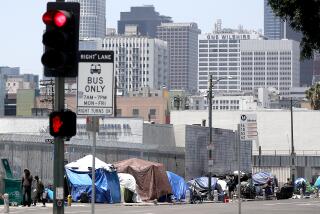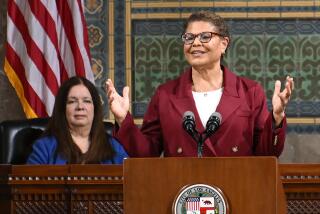Garcetti heralds L.A.’s progress, touts plan for homeless shelters

Highlights from Los Angeles Mayor Eric Garcetti’s State of the City speech.
- Share via
Mayor Eric Garcetti, fresh off a trip to Iowa to test the waters for a presidential run, delivered a State of the City address Monday that billed Los Angeles as a thriving, progressive metropolis that has hiked the minimum wage, snagged the Olympics, invested in its subway system and is tackling big issues such as climate change and gun violence.
WATCH LIVE: Mayor Garcetti delivers the 2018 State of the City speech>>
“I want to say to anyone who wants to understand who Americans are: Don’t look to D.C. — come to L.A.,” Garcetti said, heralding “an era of growth and of change in L.A.”
But the most pressing issue in Los Angeles, by far, is the tens of thousands of people bedding down on its streets.
In his City Hall speech, Garcetti announced that he would commit $20 million for emergency shelters to help get people out of squalid encampments that have popped up across the city, part of an overall increase in homelessness spending.
The mayor detailed his plan to fund new tents, trailers and other forms of emergency shelter — a program he is calling A Bridge Home — as he seeks to rally communities to “confront the greatest moral and humanitarian crisis of our time.”
The new program marks a shift for Garcetti, whose administration has focused chiefly on building housing rather than temporary shelters, an approach backed by many homeless advocacy groups. His proposal is an acknowledgment that the city has been unable to keep pace with the number of people falling into homelessness.
“We need to stand up more emergency shelters fast and we need to do it now … shelters that serve as a rest stop on the path to permanent housing,” Garcetti told the crowd of politicians, business representatives, union leaders and neighborhood advocates gathered in the City Council chambers.
Proposition HHH, the $1.2-billion voter-backed bond, will help build supportive housing over the next 10 years, but “homeless Angelenos can’t wait years to get off the streets. We need more options for bringing them inside now,” Garcetti said.
In all, Garcetti said his budget would put nearly $430 million toward the crisis next fiscal year, including more than $238 million generated by the housing bond that voters approved a year and a half ago. The mayor also plans to speed up shelter applications and sign an emergency declaration allowing the city to bypass “red tape” that slows construction, he announced Monday.
The mayor also reiterated a frequent refrain that across California, “homelessness isn’t an issue, homelessness is the issue.”
Homelessness has become the defining challenge for Garcetti, one that looms especially large as the 47-year-old Democrat flirts with running for president and travels to South Carolina, New Hampshire and Iowa. For politicians who prefer clear and resounding victories, it is a nettlesome issue, one that several in City Hall have quietly compared to the Vietnam War.
If Garcetti runs for president, “you can imagine the commercials that they will show in Iowa or New Hampshire,” said Bill Parent, a UCLA lecturer in public policy. “By the time the primary is over, people in Iowa are going to be able to draw maps of skid row.”
Garcetti’s new proposal comes amid growing pressure inside and outside City Hall to come up with solutions.
Two councilmen had urged the city to come up with a plan to shelter everyone on the streets by December, lamenting in February that there was “scant evidence of any progress” toward fixing the tattered shelter system. Activists have staged protests and camped outside City Hall to push for urgent action to shelter homeless women.
And neighborhood groups have become increasingly agitated about the blight and chaos stemming from sprawling encampments. A program to clean encampments had nearly 6,000 pending requests through early February.
The first time that Garcetti delivered a State of the City address, in 2014, he did not mention homelessness. The following year, it came up only briefly, as he touted that the city would end homelessness among veterans by the end of the year. But Garcetti ended up repeatedly delaying that goal, first to the following summer, then to the end of that year, and then indefinitely as overall homelessness continued to soar.
He recently has been touting his latest goal: ending street homelessness by 2028.
UCLA professor emeritus of law Gary Blasi was skeptical of the new effort, saying that if Garcetti truly wants to create effective shelters, they must address the needs of homeless people, not those of neighbors wanting them off the street.
“Virtually all the existing shelters are not a rational choice for people living in encampments,” Blasi said. “I’m concerned that this is an effort to manage the image of homelessness in Los Angeles” for political reasons.
But some advocates praised the plan.
Mel Tillekeratne, executive director of the skid row homeless provider Monday Night Mission, said Garcetti should advocate personally for each proposed shelter project to ease local opposition.
“He is the one the community will respond to,” Tillekeratne said. “Whenever there is a major community meeting, he needs to show up and back up the council members.”
In a meeting later with The Times’ editorial board, Garcetti said he plans to personally advocate for the shelters.
Other than his $20-million plan for shelters, the mayor included few sweeping policy proposals in his speech. He announced that Hawthorne-based SpaceX will start work on a rocket at the Port of Los Angeles.
As he contemplates entering the 2020 presidential race, Garcetti frequently contrasted Los Angeles to Washington in his speech, challenging the nation’s leadership on job creation, the environment and guns.
In the last five years, the mayor said, Los Angeles has helped create more green jobs than “the coal jobs in the nation that we have lost over the same amount of time.”
He also talked up the city’s efforts to curb gun violence with new laws including one that requires gun owners to lock up their weapons.
“The conversation on gun violence seems to have stalled out in Washington, where our national leaders are acting like teenagers or toddlers,” Garcetti said. “Wait, that’s not fair to teenagers or toddlers, especially when teenagers are providing the leadership that our elected leaders aren’t showing right now.”
Despite the mayor’s optimistic outlook, a coalition of community groups and labor unions held their own “People’s State of the City” on the steps of City Hall immediately after his speech, calling on Garcetti to hire more employees to boost city services.
Dozens of people stood holding up signs, flanked by placards of rutted streets and broken sidewalks.
“The real state of the union — here, look at the pictures — the real state of the union is that neighborhoods like mine in Watts, in South L.A., still don’t have vital city services,” said Timothy McDaniel, a member of the Alliance of Californians for Community Empowerment.
“Mr. Mayor, how do you expect to be president and fix our community when you haven’t fixed L.A.?” South Los Angeles resident Beverly Roberts said to shouts of approval from the crowd.
Twitter: @dakotacdsmith
Twitter: @alpertreyes
UPDATES:
4:50 p.m.: This article was updated with additional reaction.
12:45 p.m.: This article has been updated with a comment from UCLA professor emeritus of law Gary Blasi.
12:15 p.m.: This article has been updated with additional details from the speech.
This article was originally published at 10 a.m.
More to Read
Sign up for Essential California
The most important California stories and recommendations in your inbox every morning.
You may occasionally receive promotional content from the Los Angeles Times.














